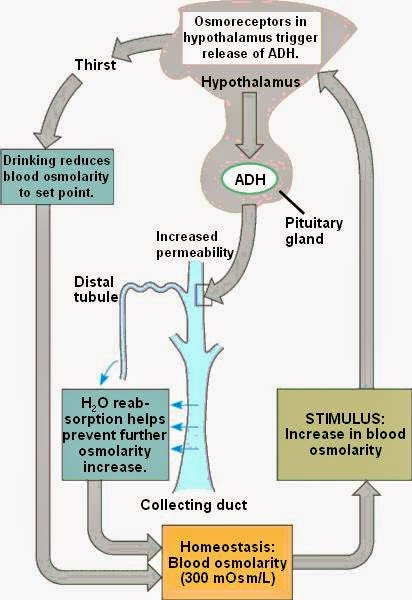Casts in urine: indicates hematuria/pyuira is of renal (vs. bladder) origin
1. RBC casts
renal: glomerulonephritis, ischemia, or malignant hypertension
bladder: bladder cancer, kidney stones --> hematuria, no casts
2. WBC casts
renal: tubulointerstitial inflammation, acute pyelonephritis, transplant rejection
bladder: acute cystitis --> pyuria, no casts
3. Fatty casts ("oval fat bodies"): nephrotic syndrome
4. Granular ("muddy brown") casts: acute tubular necrosis
5. waxy casts: Advanced renal disease/chronic renal failure
6. hyaline casts: Nonspecific, can be a normal finding
What are the three types of proteinuria?
Overflow proteinuria
Low-molecular weight proteins filtered by the glomerulus are almost entirely reabsorbed in the proximal tubule. With increased low-molecular weight protein production, the amount of filtered protein exceeds tubular reabsorptive capacity, leading to proteinuria.
Tubular proteinuria
Tubulointerstitial diseases (eg, Fanconi syndrome) can lead to decreased reabsorptive capacity of the proximal tubule and up to 2 g of proteinuria per day because of impaired tubular absorption of filtered albumin, as well as loss of tubular proteins (β2 microglobulin).
Glomerular proteinuria
Glomerular proteinuria is a sensitive marker for glomerular disease. It develops as a result of increased filtration of macromolecules (eg,
albumin) across the glomerular capillary wall .
source
Glomerular Diseases
What are the characteristics of nephrotic syndrome?
- -massive prOteinuria (>3.5 g/day; "frothy")
- -hyperlipidemia, hypercholesteremia --> fatty casts
- -hypoalbuminemia --> pitting edema
- -hypogammaglobulinemia --> increased risk of infection
- -loss of antithrombin III --> hypercoagulable state --> thromboembolism
- -normal GFR at onset
- -NO glomerular hypercellularity
What are the conditions required to diagnose nephrotic syndrome?
- proteinuria (>3 g/24 hours)
- PLUS TWO OF THE FOLLOWING
hypoalbuminemia (<3.5 g/L)
edema
hyperlipidemia
Nephrotic Syndrome:First two are non-immune associated nephrotic syndromes.1) minimal change disease:
light microscopy: normal glomeruli
electron microscopy: foot process efacement
Key characteristics: loss of albumin, selective proteinuria [selective (resulting in loss of small MW proteins such as albumin) vs non-selective (with loss of larger MW proteins, such as globulins)]
Triggered: immune stimulus
Population: children
Tx: corticosteroids
What serious disease may cause minimal change disease?
Hodgkin lymphoma: Hodgkin's lymphoma is characterised by the orderly spread of disease from one lymph node group to another and by the development of system disease with advanced disease.
What is the most common cause of nephrotic syndrome in adults, especially Hispanic and Black patients?
2) Focal segmental glomerulosclerosis
light microscopy: segmental sclerosis and hyalinosis
electron microscopy: effacement of foot process similar to minimal change disease
Population: adults (#1 nephrotic syndrome to affect adults)
Associations: HIV infection, heroin abuse, massive obesity, interferon tx, and chronic kidney disease
4 Types:
3) Membranous nephropathy
Light microscopy: diffuse capillary and GBM thickening
Electron microscopy: spike and dome appearance with sub epithelial deposits
immunofluorescence: granular, Systemic lupus erythematosus (SLE) nephrotic presentation
second most common cause of primary nephritic syndrome in adults.
associations: drugs, infection, SLE, solid tumors
4) Amyloidosis
light microscopy: congo red stain shows apple-green
birefringence under polarized light
associations: Primary= multiple myeloma
secondary = autoimmune such TB and Rheumatoid arthritis
5) Membranoproliferative glomerulonephritis (MPGN)
Type 1 = sub endothelial immune complexes deposits
immunofluorescence = granular
electron microscopy = tram-track w/ GBM splitting caused by mesangial ingrowth
association: HBV, HCV
Type 2 = intramembranous immune complexes: dense deposits
can also be presented as nephritic syndrome
association: C3 nephritic factor
6)
Diabetic glomerulonephropathy
nonenzymatic glycosylation --> increase permeability, thickening.
nonenzymatic glycosylation of efferent arterioles --> increase GFR --> mesangial expansion
light microscopy - mesangial expansion, GBM thickening,
eosinophilic nodular glomerulosclerosis =
kimmelstiel-wilson lesion
Nephritic Syndrome:
What are the symptoms of nephritic syndrome?
- -hematuria (>5 RBCs per high power field; RBC casts and dysmorphic RBCs)
- -limited proteinuria (<3.5; note that the protein is not GREATLY elevated and is nonselective)
- -oliguria and azotemia
- -impairment of renal function (abrupt increase of creatine, decreased GFR) --> retention of sodium and water --> HTN, edema
- -hypercellular, inflamed glomeruli
- -immune-complex deposition --> complement activation --> C5a attraction of neutrophils --> damage
1) Acute Poststreptococcal glomerulonephritis
light microscopy: glomeruli enlarged and hyper cellular neutrophils, "lumpy-bumpy" appearance.
electron microscopy: subepithelial immune complex (IC) humps
immunofluorescence: granular appearance due to IgG, IgM and C3 deposition along GBM and mesangium.
Population: most frequently seen in children. Peripheral and periobital edema, dark urine and hypertension.
prognosis: good. resolves spontaneously
2)
rapidly pogressive (crescentric) glomerulonephritis (RPGN):
light microscopy and immunofluorescence: crescent moon shape. crescents consist of fibrin and plasma protein with glomerular parietal cells, monocytes, and macrophages.
Prognosis: rapidly deteriorating renal function. not good.
- Goodpasture's syndrome = type ll = hypersensitivity; antibodies to GBM and alveolar basement membrane --> linear IF
- c-ANCA = Granulomatosis with polyangiitis (Wegener's)
- p-ANCA = Microscopic polyangiitis
2) Diffuse proliferative glomerulonephritis (DPGN)
- causes: SLE or MPGN
- light microscopy = wire looping of capillaries
- EM- sub endothelial and sometimes intrmaembranous IgG-based ICs often with C3 deposition
- IF - granular
- most common cause of death = SLE
3) Berger's Disease (IgA Nephropathy)
- Association: enoch-schonlein purpura
- Henoch-Schonlein purpura is a disease that involves purple spots on the skin, joint pain, gastrointestinal problems, and glomerulonephritis (a type of kidney disorder).
- LM - mesangial proliferation
- EM - mesangial IC deposits
- IF - IgA based IC deposits in mesangium
- symptoms: URI or acute gastroenteritis
4) Alphort Syndrome
- mutation in type 4 collagen --> split basement membrnae
- mode of inheritance = x linked dominant
- symptoms: deafness, ocular problems































